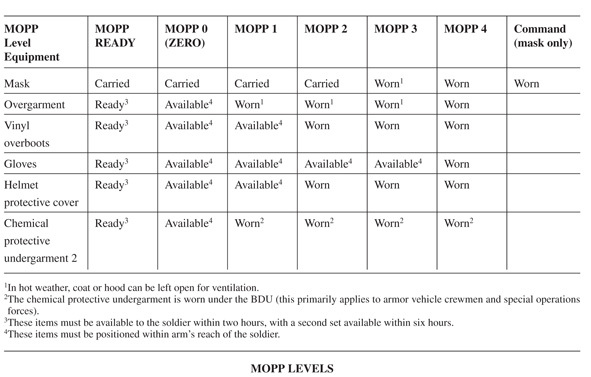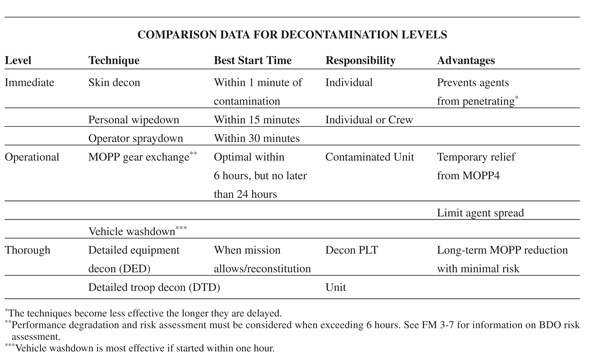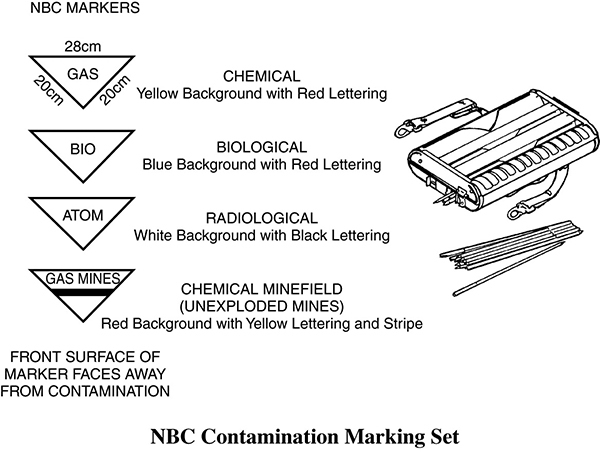NBC reconnaissance is the detection, identification, reporting, and marking of NBC hazards. It consists of search, survey, surveillance, and sampling operations.
Protection Against Contamination
Techniques that work for avoidance also work for protection (for example, shielding soldiers and units and shaping the battlefield). Other activities that comprise protection involve sealing or hardening positions, protecting soldiers, assuming mission-oriented protective posture (MOPP), reacting to attack, and using collective protection. Individual protective items include the protective mask, battle dress overgarments (BDOs), green vinyl overboots, and gloves. Higher level commanders establish the minimum level of protection; subordinate units may only increase this level as necessary.

Individual Protective Gear
Currently, most active-duty military units have the joint service lightweight integrated suit technology (JSLIST) as a replacement for the old chemical protective suit or BDOs. When combined with the chemical protective mask, the JSLIST provides protection against chemical and biological agents, radioactive fallout particles, and battlefield contaminants. The JSLIST chemical protective overgarment is currently qualified by the military to meet the requirements for protection from chemical warfare agents for up to 6 launderings, 45 days of wear, 120 calendar days after removal from the factory-sealed bag, or 24 hours after contamination, whichever comes first.
A complete chemical warfare protective ensemble includes the following components:
•Mask.
•Chemical protective overgarment.
•Chemical protective gloves.
•Chemical protective overboots (compatible with the JSLIST chemical protective overgarment).
During Operation Iraqi Freedom, the lighter nature of the JSLIST allowed the soldiers to operate in temperatures approaching 100 degrees Fahrenheit with only minimal degradation. This was a significant improvement over the BDO. However, the JSLIST proved to be not as durable as the BDO under the strenuous field conditions. Infantry soldiers easily tore many suits as they went about their day-to-day activities. It is recommended to be more careful and to have extra suits on hand.
DECONTAMINATION
Contamination forces units into protective equipment that degrades performance of individual and collective tasks. Decontamination restores combat power and reduces casualties that may result from exposure, thus allowing commanders to sustain combat operations.
Principles of Decontamination
Use the four principles of decontamination when planning decon operations:
1.Decon as soon as possible.
2.Decon only what is necessary.
3.Decon as far forward as possible (METT-TC dependent).
4.Decon by priority.
Levels of Decontamination
The three levels of decontamination are immediate, operational, and thorough.

1.Immediate. Immediate decontamination requires minimal planning. It is a basic soldier survival skill and is performed in accordance with the current soldier manual. Personal wipedown removes contamination from individual equipment using the M291.
2.Operational. Operational decontamination involves MOPP gear exchange and vehicle spraydown. MOPP gear exchange should be performed within six hours of being contaminated when thorough decon cannot be performed.
3.Thorough. Thorough decontamination involves detailed troop decontamination (DTD) and detailed equipment decontamination (DED). Thorough decontamination is normally conducted by company-size elements as part of restoration or during breaks in combat operations. These operations require support from a chemical decontamination platoon.
Decontamination Planning Considerations
Leaders should include the following when planning for decontamination:
•Plan decon sites throughout the width and depth of the sector.
•Tie decon sites to the scheme of maneuver and template NBC strikes.
•Apply the principles of decontamination.
•Plan for contaminated routes.
•Plan for logistics and resupply of MOPP, mask parts, water, and decon supplies.
•Plan for medical concerns, including treatment and evacuation of contaminated casualties.
•Maintain site security.
MARKING CONTAMINATION
When contamination is found, it must be marked to prevent other soldiers from being exposed, and then reported. The only exception to marking an area is if the marking would help the enemy avoid contamination; however, the contaminated area must still be reported. When marking an area, place the markers facing away from the contamination. Markers are placed at roads, trails, and other likely points of entry.
PASSING ALARMS AND SIGNALS
The vocal alarm for any chemical or biological hazard or attack is the word “gas.” The person giving the alarm stops breathing, masks, and shouts “Gas!” as loudly as possible. Everyone hearing this immediately masks and passes the alarm.
The first person to hear or see the M8 automatic chemical alarm sound or flash also stops breathing, masks, and yells “Gas!”

The all-clear signal is given by word of mouth through the chain of command. The signal is given by leaders after testing for contamination proves negative.
TREATMENT OF CHEMICAL CASUALTIES
Following the all-clear signal, soldiers check for casualties, give first aid, identify the agent, send reports to higher headquarters, request permission to move, schedule decontamination operations, and mark the area to warn friendly soldiers.
Antidote Treatment, Nerve Agent, Auto-Injector
The ATNAA is a nerve agent antidote device that will be used by the Armed Forces in the treatment of nerve agent poisoning. It is a multichambered device consisting of three components: the auto-injector tube, a spring-activated needle, and a safety cap. The device is packaged in a chemically hardened pouch.

First Aid for Chemical Casualties
Soldiers must be able to treat themselves and each other after exposure to dangerous chemicals.
Self-Aid. If you experience most or all of the mild symptoms of nerve agent poisoning, immediately hold your breath. Do not inhale. Put on your protective mask and administer one ATNAA injection into your lateral thigh muscle or buttocks. It will take ten to fifteen minutes for the antidote to take effect. If you are able to ambulate and know who and where you are, you will not need a second ATNAA injection.
Warning: Giving yourself a second ATNAA injection may create a nerve agent antidote overdose, which could result in incapacitation. If symptoms of nerve agent poisoning are not relieved after administering one ATNAA injection, seek someone else to check your symptoms. A buddy must administer the second and third sets of injections, if needed.
Buddy Aid. If you encounter a servicemember suffering from severe signs of nerve agent poisoning, mask the casualty if necessary. Do not fasten the hood. Administer three ATNAAs in rapid succession. Follow administration procedures outlined below.
Combat Lifesaver Procedures. The combat lifesaver (CLS) must check to verify if the individual has received three ATNAAs. If not, the CLS performs first aid as described for buddy aid above. If the individual has received the initial three ATNAAs, then the CLS may administer additional atropine injections at approximately fifteen-minute intervals until atropinization is achieved (heart rate above 90 beats per minute, reduced bronchial secretions, and reduced salivations). Administer additional atropine at intervals of thirty minutes to four hours to maintain atropinization or until the casualty is placed under the care of medical personnel. Check the heart rate by carefully lifting the casualty’s mask hood and feeling for a pulse at the carotid artery. Request medical assistance as soon as the tactical situation permits.